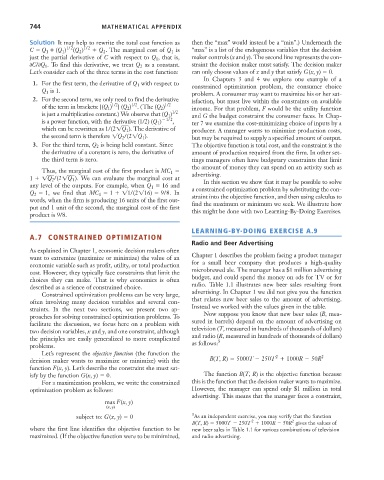Page 770 - Microeconomics, Fourth Edition
P. 770
BMappAMathematicalAppendix.qxd 8/17/10 1:10 AM Page 744
744 MATHEMATICAL APPENDIX
Solution It may help to rewrite the total cost function as then the “max” would instead be a “min”.) Underneath the
C Q 1 (Q 1 ) 1/2 (Q 2 ) 1/2 Q 2 . The marginal cost of Q 1 is “max” is a list of the endogenous variables that the decision
just the partial derivative of C with respect to Q 1 , that is, maker controls (x and y). The second line represents the con-
0C/0Q 1 . To find this derivative, we treat Q 2 as a constant. straint the decision maker must satisfy. The decision maker
Let’s consider each of the three terms in the cost function: can only choose values of x and y that satisfy G(x, y) 0.
In Chapters 3 and 4 we explore one example of a
1. For the first term, the derivative of Q 1 with respect to constrained optimization problem, the consumer choice
Q 1 is 1.
problem. A consumer may want to maximize his or her sat-
2. For the second term, we only need to find the derivative isfaction, but must live within the constraints on available
1/2
1/2
of the term in brackets: [(Q 1 ) ] (Q 2 ) . (The (Q 2 ) 1/2 income. For that problem, F would be the utility function
is just a multiplicative constant.) We observe that (Q 1 ) 1/2 and G the budget constraint the consumer faces. In Chap-
is a power function, with the derivative (1/2) (Q 1 ) 1/2 , ter 7 we examine the cost-minimizing choice of inputs by a
which can be rewritten as 1/(21Q 1 ) . The derivative of producer. A manager wants to minimize production costs,
the second term is therefore 1Q 2 /(21Q 1 ) . but may be required to supply a specified amount of output.
3. For the third term, Q 2 is being held constant. Since The objective function is total cost, and the constraint is the
the derivative of a constant is zero, the derivative of amount of production required from the firm. In other set-
the third term is zero. tings managers often have budgetary constraints that limit
the amount of money they can spend on an activity such as
Thus, the marginal cost of the first product is MC 1 advertising.
1 1Q 2 /(21Q 1 ) . We can evaluate the marginal cost at In this section we show that it may be possible to solve
any level of the outputs. For example, when Q 1 16 and a constrained optimization problem by substituting the con-
Q 2 1 , we find that MC 1 1 11/(2116) 9/8 . In straint into the objective function, and then using calculus to
words, when the firm is producing 16 units of the first out- find the maximum or minimum we seek. We illustrate how
put and 1 unit of the second, the marginal cost of the first this might be done with two Learning-By-Doing Exercises.
product is 9/8.
LEARNING-BY-DOING EXERCISE A.9
A.7 CONSTRAINED OPTIMIZATION
Radio and Beer Advertising
As explained in Chapter 1, economic decision makers often
want to extremize (maximize or minimize) the value of an Chapter 1 describes the problem facing a product manager
economic variable such as profit, utility, or total production for a small beer company that produces a high-quality
cost. However, they typically face constraints that limit the microbrewed ale. The manager has a $1 million advertising
choices they can make. That is why economics is often budget, and could spend the money on ads for TV or for
described as a science of constrained choice. radio. Table 1.1 illustrates new beer sales resulting from
Constrained optimization problems can be very large, advertising. In Chapter 1 we did not give you the function
often involving many decision variables and several con- that relates new beer sales to the amount of advertising.
straints. In the next two sections, we present two ap- Instead we worked with the values given in the table.
proaches for solving constrained optimization problems. To Now suppose you know that new beer sales (B, mea-
facilitate the discussion, we focus here on a problem with sured in barrels) depend on the amount of advertising on
two decision variables, x and y, and one constraint, although television (T, measured in hundreds of thousands of dollars)
the principles are easily generalized to more complicated and radio (R, measured in hundreds of thousands of dollars)
5
problems. as follows:
Let’s represent the objective function (the function the 2 2
decision maker wants to maximize or minimize) with the B(T, R) 5000T 250T 1000R 50R
function F(x, y). Let’s describe the constraint she must sat-
isfy by the function G(x, y) 0. The function B(T, R) is the objective function because
For a maximization problem, we write the constrained this is the function that the decision maker wants to maximize.
optimization problem as follows: However, the manager can spend only $1 million in total
advertising. This means that the manager faces a constraint,
max F(x, y)
(x, y)
subject to: G(x, y) 0 5 As an independent exercise, you may verify that the function
2
2
B(T, R) 5000T 250T 1000R 50R gives the values of
where the first line identifies the objective function to be new beer sales in Table 1.1 for various combinations of television
maximized. (If the objective function were to be minimized, and radio advertising.

